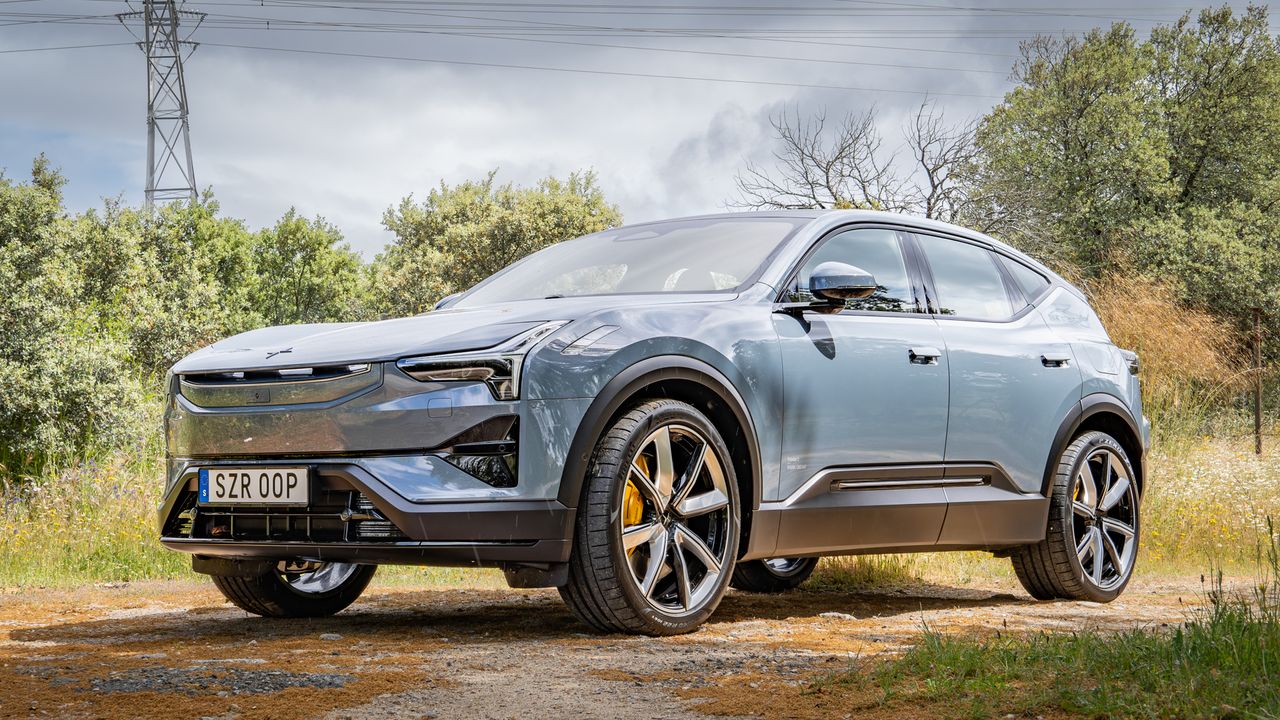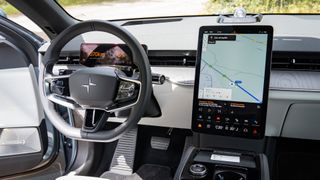AutoElectric VehiclesPolestar 3 first drive: the electric SUV that thinks it’s a sports carPolestar’s new full-size SUV mixes Scandi-cool with a sporty drive and a killer sound systemWhen you purchase through links on our site, we may earn an affiliate commission.Here’s how it works.
AutoElectric VehiclesPolestar 3 first drive: the electric SUV that thinks it’s a sports carPolestar’s new full-size SUV mixes Scandi-cool with a sporty drive and a killer sound systemWhen you purchase through links on our site, we may earn an affiliate commission.Here’s how it works.
Polestar’s new full-size SUV mixes Scandi-cool with a sporty drive and a killer sound system
When you purchase through links on our site, we may earn an affiliate commission.Here’s how it works.
(Image credit: Future)

(Image credit: Future)
Here I’m focusing on the Polestar 3, which I first sampled as a prototypeon a frozen Arctic lake, and have now driven on the roads of Madrid. Priced from £75,900 (or about £1,000 a month), the 3 is available to order now and deliveries of the ‘launch edition’ version (which costs £4,000 more) are due to kick-off in September. It’s a dual-motor, all-wheel-drive electric car, with a single-motor variant joining the lineup later.
Dimensions and performance
(Image credit: Future)

(Image credit: Future)
Like the 2, the Polestar 3 is a tricky car to define. I’ve already referred to it as a full-size SUV, but it’s strictly a five-seater with no option for seven, and the low roofline suggests it’s not really an SUV at all. But then it’s based on the same platform as the upcomingVolvo EX90, which is most definitely an SUV. Perhaps “SUV” doesn’t really mean anything anymore?
Best to stick to the dimensions and let you define it yourself. The Polestar 3 is 4,900 mm long, 1,614 mm tall and 1,968 mm wide. Its relative lack of height, paired with a roofline that slopes downwards at the rear and the use of black trim along the sills, makes it seem more compact than it really is. This sensation remains when you step behind the wheel, but from the rear seats you realise just how big the 3 is, as there’s acres of leg room in the second row, and a good amount of headroom too.
The exterior design is sharp and distinctive, with LED lights front and rear, flush door handles that protrude electronically when they’re needed, and a glass house that tapers dramatically to a point at the rear. A clever approach to aerodynamics sees the 3 gain a spoiler at the front as well as the rear, the former guiding air over the bonnet and steeply-raked windscreen, while the rear cleans up air as it departs from the roof and shallow rear screen. I think it looks fantastic, especially in Polestar’s ‘snow’ white paint option, while the gold brake callipers, seatbelts and tyre air valves look a lot classier than they sound, but are only available as part of the £5,600 Performance Pack.
(Image credit: Future)

(Image credit: Future)
The total combined output is 360 kW, or 483 horsepower. Torque is a chunky 841 Nm (620 lb-ft), the 0-60 mph time is a claimed 4.8 seconds and the top speed is 130 mph. The Performance Pack adds an extra 27 horsepower and 69 Nm and reduces the 60 mph sprint to 4.5 seconds, while v-max remains the same. Crucially, the extra power sees the WLTP range fall from 392 miles to 348 miles. Given the marginal performance gains on offer, I feel the Performance Pack won’t be worth it for most customers.
Sign up to the T3 newsletter for smarter living straight to your inbox
Get all the latest news, reviews, deals and buying guides on gorgeous tech, home and active products from the T3 experts
The Polestar 3 has a large, 111 kWh battery pack that uses a 400-volt system architecture. I’d like to have seen Polestar take the leap up to 800 volts, as Kia, Hyundai and Porsche already have, but the 3’s maximum charge rate of 250 kW is still impressive. Polestar claims the battery can charge from 10 to 80 percent in 30 minutes when connected to a 250 kW charger, or from zero to 100 percent in 11 hours using an 11 kW wall box at home.
There are three levels of regenerative braking. You can either have it switched off, set to a one-pedal driving mode where the 3 will bring itself to a stop without you pressing the brake pedal, or a halfway house.
Tech and infotainment
(Image credit: Future)

(Image credit: Future)
Although it is broadly similar to the systems of theVolvo EX30and EX90, Polestar is keen to stress how much effort it has put into making the user interface its own. The company even created its own icons for the UI, and has clearly thought long and hard about how drivers use the system.
Instead of confusing and potentially distracting the driver with pages of adjustable settings arranged into lists, like that of Volvo’s UI, the Polestar 3 uses large icons and high-contrast colours to aid menu navigation. Icons of the grid-style interface turn from black or white to orange when they are selected, making it easier to interpret with a glance. As with all modern cars with large touchscreens, the system takes time to learn – more time that is usually available on test drives like this. So, while I can say the navigation is intuitive and it’s easy enough to play music and adjust the cabin temperature, I’ll reserve judgement on the infotainment as a whole until I’ve spent time truly living with it.
(Image credit: Future)

(Image credit: Future)
There’s real potential here though, as musicians start to experiment with how a voice or an instrument’s position relative to the listener can be changed, adding a new dimension to music. The Bowers & Wilkins system also uses active noise cancelling, like you get in thebest wireless headphones, to help cancel out the monotonous drone of wind, tyre and road noise. There’s even a pair of 40mm speakers in each of the front headrests to further enhance the surround sound experience, and those on the driver’s side can be used to discreetly deliver phone calls and navigation instructions without disturbing the passengers.
Driving impressions
(Image credit: Polestar)

(Image credit: Polestar)
Polestar likes to position itself as a sportier alternative to Volvo, while still packing a whole heap of Swedish style and sensibility. With the 3, it has nailed the brief. This is a big car that feels much smaller than it really is, thanks to the composure of its dual-chamber air suspension and the eagerness of the steering. It doesn’t feel overly alert, or pretend to be something it isn’t, but there’s a sharpness that disguises the weight and encourages the driver to push the 3 more than I suspect they would in the related Volvo EX90.
The 3 hides its weight well – at almost 2,600 kg, that’s quite the achievement – and gives the driver plenty of confidence to press on when the mood takes them. It’s not really a sports car, despite what Polestar’s marketing material says, but it’s certainly an SUV with an engaging and sporty feel.
I drove the regular 3 and felt its 483 horsepower was plenty. It might be tempting to tick the Performance pack box, but an extra 27 horsepower and a slightly quicker 0-60 mph time (4.5 vs 4.8 seconds) doesn’t seem worth it. I’d rather stick with the base model and enjoy the extra range – a WLTP claim of 392 miles, versus 348.
On that note, the car I drove indicated a maximum range of 329 miles, but that estimate will have taken the driving style of the previous journalist into account, so it doesn’t tell the whole story. With regard to average efficiency, I saw the Polestar 3 range from 20.5 to 28 kWh per 100 km. This equates to between 3.0 and 2.2 miles per kWh. I’m keen to spend more time with the Polestar 3 and see how that efficiency averages out over longer journeys.
Should I buy a Polestar 3?
(Image credit: Polestar)

(Image credit: Polestar)
The Polestar 3 does not disappoint. From the restrained but recognisable Swedish styling, to the spacious interior, intuitive tech and sporty driving dynamics, the 3 is a fantastic addition to the Polestar family. It’s undoubtedly a large car, and while some buyers will look elsewhere due to the 3’s seating for five instead of seven, those who don’t need a third row will love the masses of space the airy cabin provides.
Some might also question the lack of physical controls, but to its credit Polestar has clearly put thought into the user interface. While I’d still prefer physical controls for things like the mirrors, steering wheel and cabin temperature, the UI is among the best I have used, and the inclusion of a driver display is welcome.
The 3 isn’t quite the sports car in SUV clothing Polestar claims, but it comes surprisingly close. Packing both power and poise, it’s a surprisingly fun car to drive while still being comfortable on a cruise.
I’m still curious to know whether that near-400 mile range is truly achievable in everyday use, or if the realistic range is closer to 300 miles. Even still, that’s an impressive feat for such a big car – and quick charging means long-haul drivers won’t be stationary for long. There’s a lot to like here, and while £80,000 (or £1,000 a month) positions the 3 well above the circa-£44,000 2, the Polestar brand feels more than capable of venturing up-market.
Today’s best EV Chargers deals$599View$599View$649$599.99ViewWe check over 250 million products every day for the best prices
Today’s best EV Chargers deals$599View$599View$649$599.99ViewWe check over 250 million products every day for the best prices
Today’s best EV Chargers deals
$599View$599View$649$599.99View
$599View
$599View


$599View
$599
$599
$599View
$599View



$599View
$599
$599
$649$599.99View
$649$599.99View



$649$599.99View
$649$599.99
$599.99
We check over 250 million products every day for the best prices
We check over 250 million products every day for the best prices

Bowers & Wilkins Pi6 review: sensational sound, ordinary ANCBowers & Wilkins' step-down true wireless earbuds sound amazing and are well-priced – so what’s the catch, if anything?
Bowers & Wilkins' step-down true wireless earbuds sound amazing and are well-priced – so what’s the catch, if anything?

Try this 4-week core workout plan to build strength, stability, and definitionUnlock full-body power with this simple yet effective core routine – no endless crunches, just real results
Unlock full-body power with this simple yet effective core routine – no endless crunches, just real results